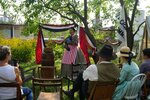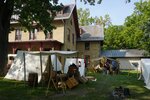For the weekend of September 7 at the LeDuc Historic Estate, the year was not 2024, but 1864. Union soldiers drilled in the yard, cannons were fired, and ballots were cast for Lincoln and McClellan, …
This item is available in full to subscribers.
To continue reading, you will need to either log in, using the login form, below, or purchase a new subscription.
If you are a current print subscriber, you can set up a free website account and connect your subscription to it by clicking here.
Otherwise, click here to view your options for subscribing.
Please log in to continue |




For the weekend of September 7 at the LeDuc Historic Estate, the year was not 2024, but 1864. Union soldiers drilled in the yard, cannons were fired, and ballots were cast for Lincoln and McClellan, with commissioners bickering over if troops were old enough to vote based on their ability to grow a beard. The LeDuc’s Civil War Weekend was in full swing.
The LeDuc’s annual Civil War Weekend is a chance for reenactors, educators, and history buffs alike to showcase what life was like during the United States’ bloodiest war. Events included drilling and firing demonstrations, as well as broader period-accurate displays like demonstrations for medical practices and tools at the time.
Each year’s Civil War Weekend is characterized by a theme, with this year’s being ‘1864.’ The year 1864 is significant to the here and now for many reasons, key among them is that it too was a presidential election year. The stakes of the contest between Abraham Lincoln and George McClellan were high. The Union quite literally hung in the balance: McCellan wanted to make peace with the Confederacy and let them secede. In addition, “It was the first time soldiers in the field voted,” said Spencer Johnson, former American History teacher at the Hastings Middle School and member of the Dakota County Historical Society. The struggle to cast and collect votes during wartime quite literally changed how people voted and that shift as well as the backlash to it, resonates even today.
What is so poignant about soldiers voting during this time is that in Minnesota, the absentee ballot was adopted for the first time in the state to allow soldiers to vote from the field. In an 1861 special session, the 3-year-old Minnesota adopted the absentee ballot and it was widely used in the 1864 election and was allowed until 1866. This widespread use of absentee ballots wouldn’t return until the 20th Century.
Commissioners were sent out with ballots to find Minnesota regiments and allow them to vote. “Each Commissioner, one was for the Union Party, and one was for the Democratic Party, traveled together. […] They would send commissioners out west. They would send commissioners out east, and they would send commissioners to the South,” said Heather Loeschke, US History teacher at Cannon Falls High School.
In 1864, the United States didn’t use an Australian ballot, otherwise known as a secret ballot. Parties would print colorful tickets and voters would sign their name onto that ticket and deposit them into a voting receptacle, something as simple as a tin cup for soldiers in the field. “There was no secrecy about this whatsoever,” said Loeschke.
Despite onlooking partisan commissioners, the lack of secret ballots allowed for an incredible amount of coercion between officers and troops and troops among themselves. Soldiers were heavily pro-Lincoln and casting a ballot for former general George McCellan could be difficult. “Soldiers were told if you don’t vote for Lincoln, think about all those fallen comrades, it would have been for nothing,” said Loeschke. In fact, Democrats at the time, knowing that soldiers overwhelming supported their Commander-in-Chief didn’t want soldiers to vote at all claiming the practice of absentee ballots would “lead to fraudulent activity,” said Loeschke.
The Politics of Historical Reenactment
As is so often the case, history is not settled. In working to preserve it, that history, especial the ugly parts, can run against modern sensibilities, norms, and decorum. It was a sentiment echoed through several of the reenactors at the event. In the year 2024, portraying Confederate soldiers and flying the Confederate battle flag are often seen as unacceptable, even at reenactment events. While slavery and the rebellion it caused is a fact of this country’s history, how to portray it and talk about it is very much still up for debate.
In previous years, the Leduc’s Civil War Weekend would have reenactors of Confederate soldiers. “They would use the national flag and talk about that and cook some Southern food. […] But the last couple of years, we’ve sort of—and I feel bad about this—avoided having Confederate enactors here because it’s kind of a hot button issue these days,” said Johnson. This lack of problematic historical figures is “not really erasing history, but it’s not really remembering it either,” lamented Johnson
That hesitancy around the portrayal of Confederate soldiers, is not isolated to the LeDuc’s Civil War Weekend.
The 2021 Olmstead County Living History Fair banned the flying of the Confederate battle flag, and the practice of welcoming Confederate reenactors at state historic sites like Fort Snelling or Fort Ridgely has largely stopped according to several reenactment groups that had previously attended events there.
This hostility to Confederate reenactors dovetails into the larger argument of how to address problematic historical figures like slave owners or Confederate generals: remove them from the public eye or let them remain.
For many of the reenactors at the event, including retired educator and member of the First Minnesota Volunteer Infantry Regiment Arn Kind, “When you take a statue down, you are taking down a reason to teach.” Kind bristled against this type of removing problematic historical figures or symbols from the public eye. For Kind, the ability to provide context to these figures and events and thereby teach why the figure is deemed problematic, is useful.
One example of this erasure Kind brought up was the recent change to the state flag. The Minnesota State flag had long been pilloried as if not outright racist, highly problematic. The previous state flag depicted a white settler plowing land before a native American on horseback to the west. According to Kind, in changing the flag, educators are losing an opportunity to unpack the history that went into its creation and thereby the history of white settlers and the native peoples in what would later become Minnesota. While the new flag no longer depicts a white settler pushing out a native person, it obfuscates that fact that that did happen in Minnesota.
For more information about the LeDuc’s programming, visit https://dakotahistory.org/leduc-historic-estate